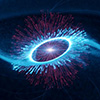 Scientists have detected the highest energy gamma rays ever from a dead star called a pulsar. The energy of these gamma rays clocked in at 20 tera-electronvolts, or about ten trillion times the energy of visible light. This observation is hard to reconcile with the theory of the production of such pulsed gamma rays.
Scientists have detected the highest energy gamma rays ever from a dead star called a pulsar. The energy of these gamma rays clocked in at 20 tera-electronvolts, or about ten trillion times the energy of visible light. This observation is hard to reconcile with the theory of the production of such pulsed gamma rays.
Oct 5th, 2023
Read more
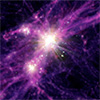 Intense flashes of light, not mass, resolve the puzzle of impossible brightness.
Intense flashes of light, not mass, resolve the puzzle of impossible brightness.
Oct 3rd, 2023
Read more
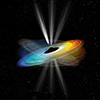 The supermassive black hole at the heart of galaxy M87, made famous by the first picture of a black hole shadow, has yielded another first: the jet shooting out from the black hole has been confirmed to wobble, providing direct proof that the black hole is spinning.
The supermassive black hole at the heart of galaxy M87, made famous by the first picture of a black hole shadow, has yielded another first: the jet shooting out from the black hole has been confirmed to wobble, providing direct proof that the black hole is spinning.
Sep 27th, 2023
Read more
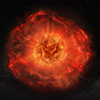 A newly discovered nearby supernova whose star ejected up to a full solar mass of material in the year prior to its explosion is challenging the standard theory of stellar evolution. The new observations are giving astronomers insight into what happens in the final year prior to a star's death and explosion.
A newly discovered nearby supernova whose star ejected up to a full solar mass of material in the year prior to its explosion is challenging the standard theory of stellar evolution. The new observations are giving astronomers insight into what happens in the final year prior to a star's death and explosion.
Sep 27th, 2023
Read more
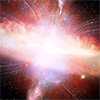 Astronomers have found a striking link between the amount of dust surrounding a supermassive black hole and the strength of the radio emission produced in extremely bright galaxies.
Astronomers have found a striking link between the amount of dust surrounding a supermassive black hole and the strength of the radio emission produced in extremely bright galaxies.
Sep 25th, 2023
Read more
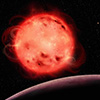 Astronomers have made important progress in understanding the intriguing TRAPPIST-1 exoplanetary system, which was first discovered in 2016 amid speculation it could someday provide a place for humans to live.
Astronomers have made important progress in understanding the intriguing TRAPPIST-1 exoplanetary system, which was first discovered in 2016 amid speculation it could someday provide a place for humans to live.
Sep 25th, 2023
Read more
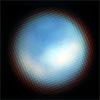 Astronomers have identified carbon dioxide in a specific region on the icy surface of Europa. Analysis indicates that this carbon likely originated in the subsurface ocean and was not delivered by meteorites or other external sources.
Astronomers have identified carbon dioxide in a specific region on the icy surface of Europa. Analysis indicates that this carbon likely originated in the subsurface ocean and was not delivered by meteorites or other external sources.
Sep 22nd, 2023
Read more
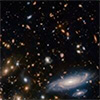 Early galaxies followed a formation 'rulebook', according to researchers using the James Webb Space Telescope, but this cosmic rulebook appears to have been dramatically rewritten during the universe's infancy.
Early galaxies followed a formation 'rulebook', according to researchers using the James Webb Space Telescope, but this cosmic rulebook appears to have been dramatically rewritten during the universe's infancy.
Sep 22nd, 2023
Read more
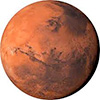 The first use of a novel method of analyzing Mars' gravitational force supports the idea that the planet once had an extensive northern ocean.
The first use of a novel method of analyzing Mars' gravitational force supports the idea that the planet once had an extensive northern ocean.
Sep 20th, 2023
Read more
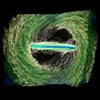 A new study is changing the way astrophysicists understand the eating habits of supermassive black holes. While previous researchers have hypothesized that black holes eat slowly, new simulations indicate that black holes scarf food much faster than conventional understanding suggests.
A new study is changing the way astrophysicists understand the eating habits of supermassive black holes. While previous researchers have hypothesized that black holes eat slowly, new simulations indicate that black holes scarf food much faster than conventional understanding suggests.
Sep 20th, 2023
Read more
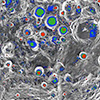 Moon's permanently shadowed regions are younger than previously estimated.
Moon's permanently shadowed regions are younger than previously estimated.
Sep 18th, 2023
Read more
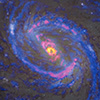 New research shows that the supermassive black hole at the center of a galaxy can have a direct impact on the chemical distribution of the host galaxy. This provides another piece of the puzzle for understanding how galaxies evolve.
New research shows that the supermassive black hole at the center of a galaxy can have a direct impact on the chemical distribution of the host galaxy. This provides another piece of the puzzle for understanding how galaxies evolve.
Sep 15th, 2023
Read more
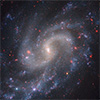 A persistent difference called the 'Hubble Tension' is seen between the value of the constant measured with a wide range of independent distance indicators and its value predicted from the big bang afterglow.
A persistent difference called the 'Hubble Tension' is seen between the value of the constant measured with a wide range of independent distance indicators and its value predicted from the big bang afterglow.
Sep 14th, 2023
Read more
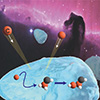 Lab-based studies reveal how carbon atoms diffuse on the surface of interstellar ice grains to form complex organic compounds, crucial to reveal the chemical complexity in the universe.
Lab-based studies reveal how carbon atoms diffuse on the surface of interstellar ice grains to form complex organic compounds, crucial to reveal the chemical complexity in the universe.
Sep 14th, 2023
Read more
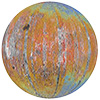 Scientists discovered that high energy electrons in Earth's plasma sheet are contributing to weathering processes on the Moon's surface and, importantly, the electrons may have aided the formation of water on the lunar surface.
Scientists discovered that high energy electrons in Earth's plasma sheet are contributing to weathering processes on the Moon's surface and, importantly, the electrons may have aided the formation of water on the lunar surface.
Sep 14th, 2023
Read more
 A research team relies on measuring the number of galaxy members to determine the mass of galaxy clusters.
A research team relies on measuring the number of galaxy members to determine the mass of galaxy clusters.
Sep 14th, 2023
Read more
 A collision of two massive clusters of galaxies when the Universe was half its current age should not have happened according to the standard theory of cosmology, says a new study by an international group of astronomers.
A collision of two massive clusters of galaxies when the Universe was half its current age should not have happened according to the standard theory of cosmology, says a new study by an international group of astronomers.
Sep 14th, 2023
Read more
 A new study hints at the existence of several black holes in the Hyades cluster - the closest open cluster to our solar system - which would make them the closest black holes to Earth ever detected.
A new study hints at the existence of several black holes in the Hyades cluster - the closest open cluster to our solar system - which would make them the closest black holes to Earth ever detected.
Sep 8th, 2023
Read more
 Scientists have detected the highest energy gamma rays ever from a dead star called a pulsar. The energy of these gamma rays clocked in at 20 tera-electronvolts, or about ten trillion times the energy of visible light. This observation is hard to reconcile with the theory of the production of such pulsed gamma rays.
Scientists have detected the highest energy gamma rays ever from a dead star called a pulsar. The energy of these gamma rays clocked in at 20 tera-electronvolts, or about ten trillion times the energy of visible light. This observation is hard to reconcile with the theory of the production of such pulsed gamma rays.
 Subscribe to our Space Exploration News feed
Subscribe to our Space Exploration News feed















